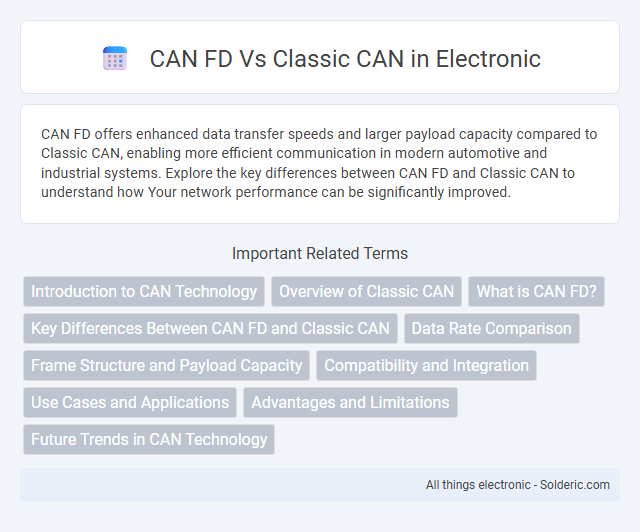CAN FD offers enhanced data transfer speeds and larger payload capacity compared to Classic CAN, enabling more efficient communication in modern automotive and industrial systems. Explore the key differences between CAN FD and Classic CAN to understand how Your network performance can be significantly improved.
Comparison Table
| Feature | CAN FD (Flexible Data-rate) | Classic CAN |
|---|---|---|
| Data Transfer Rate | Up to 8 Mbps | Up to 1 Mbps |
| Maximum Data Payload | 64 bytes per frame | 8 bytes per frame |
| Frame Format | Extended frame with flexible data length | Fixed frame with standard length |
| Backward Compatibility | Partially compatible with Classic CAN | Fully compatible within Classic CAN networks |
| Error Detection | Improved error detection and CRC length | Standard CRC and error checking |
| Use Cases | High-speed and large data transfer applications | Standard automotive and industrial control |
| Bit Stuffing | Same as Classic CAN | Used in all frames |
| Protocol Complexity | More complex due to flexible data rate | Simpler protocol, widely adopted |
Introduction to CAN Technology
CAN technology, or Controller Area Network, facilitates reliable communication between microcontrollers and devices without a host computer, primarily used in automotive and industrial applications. Classic CAN supports data transmission rates up to 1 Mbps with an 8-byte data frame, while CAN FD (Flexible Data-rate) enhances this by increasing the data rate beyond 1 Mbps and allowing data payloads up to 64 bytes. The advancements in CAN FD improve network efficiency and data throughput, enabling more complex data exchanges and real-time system performance.
Overview of Classic CAN
Classic CAN (Controller Area Network) operates with data rates up to 1 Mbps and supports 8-byte data frames, providing reliable communication for automotive and industrial applications since the 1980s. Its robust error detection mechanisms and deterministic arbitration ensure message integrity and collision-free transmission across multiple nodes. Your system benefits from Classic CAN's proven real-time capabilities, though it may face limitations in bandwidth and data throughput compared to CAN FD.
What is CAN FD?
CAN FD (Flexible Data-rate) is an advanced version of the Classic CAN protocol designed to enhance data transmission speeds and payload capacity in automotive and industrial networks. Unlike Classic CAN, which limits data frames to 8 bytes and a maximum data rate of 1 Mbps, CAN FD supports payloads up to 64 bytes and data rates exceeding 8 Mbps. This increased flexibility allows faster communication and improved efficiency for complex electronic control units (ECUs) in modern vehicles.
Key Differences Between CAN FD and Classic CAN
CAN FD (Controller Area Network Flexible Data-rate) offers higher data transfer rates up to 8 Mbps compared to Classic CAN's maximum of 1 Mbps, enabling faster communication in automotive and industrial applications. Unlike Classic CAN, CAN FD supports larger data payloads of up to 64 bytes per frame rather than the 8-byte limit, improving data efficiency and reducing latency. Your system can benefit from CAN FD's improved error handling and flexible data length, making it a superior choice for modern network requirements.
Data Rate Comparison
CAN FD supports data rates up to 8 Mbps, significantly outperforming Classic CAN's maximum of 1 Mbps. This increased speed enables faster transmission of larger data packets, enhancing communication efficiency in automotive and industrial applications. Your system can benefit from reduced latency and improved throughput when upgrading to CAN FD technology.
Frame Structure and Payload Capacity
CAN FD (Flexible Data-rate) enhances the traditional Classic CAN frame structure by extending the data field from 8 to 64 bytes, significantly increasing payload capacity. Unlike Classic CAN, which uses a fixed 8-byte data limit, CAN FD introduces a flexible data length code (DLC) allowing variable payload sizes and faster bit rates during data transmission. This expanded frame structure enables higher data throughput and improved efficiency for modern automotive and industrial network applications.
Compatibility and Integration
CAN FD offers backward compatibility with Classic CAN, allowing seamless integration into existing automotive and industrial networks without replacing all hardware. Your system can leverage higher data rates up to 8 Mbps and larger payload sizes in CAN FD while maintaining communication with Classic CAN devices at 1 Mbps and 8-byte frames. This compatibility ensures smooth transitions and scalability in complex control networks, optimizing performance without extensive redesign.
Use Cases and Applications
CAN FD (Flexible Data-rate) is preferred in automotive and industrial automation sectors requiring higher data throughput and enhanced real-time performance, such as advanced driver-assistance systems (ADAS) and electric vehicle battery management. Classic CAN remains widely utilized in simpler applications like engine control units (ECUs), body control modules, and older automotive networks due to its robustness and existing infrastructure. Industries with evolving communication needs gradually adopt CAN FD for scalable bandwidth, improved diagnostics, and efficient firmware updates.
Advantages and Limitations
CAN FD offers higher data transmission rates up to 8 Mbps compared to Classic CAN's maximum of 1 Mbps, allowing for faster communication and improved efficiency in modern automotive and industrial applications. It supports larger data frames up to 64 bytes instead of the 8-byte limit in Classic CAN, enhancing the capability to transfer more information per message. Your system may face compatibility challenges, as CAN FD requires updated hardware and software, unlike Classic CAN which remains widely supported and simpler in legacy environments.
Future Trends in CAN Technology
CAN FD (Flexible Data-rate) offers significant advancements over Classic CAN by supporting higher data rates up to 8 Mbps and larger payloads of up to 64 bytes, enabling faster and more efficient communication in automotive and industrial applications. Future trends in CAN technology emphasize increasing data transmission speeds, enhancing network security features to protect against cyber threats, and integrating with emerging protocols for autonomous driving and Industry 4.0. Your systems will benefit from these innovations by achieving lower latency and improved reliability, positioning CAN FD as the standard for next-generation vehicle and machine networks.
CAN FD vs Classic CAN Infographic

 solderic.com
solderic.com